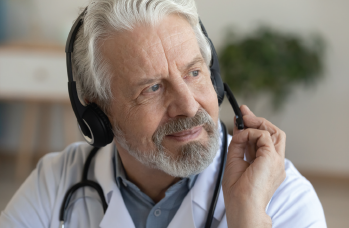Our lives have changed significantly since COVID-19’s onset. Among those changes is a broad shift toward working from home and socializing virtually. For many of us, that means extended hours using video-enabled virtual communication systems. Professionally, these platforms have allowed us to provide services to our patients remotely. While there are clear benefits to virtual communication, extended use can also increase the risk of developing voice and hearing problems.
Explore This Issue
January 2021If telehealth is part of your new normal, you may need to make changes to maintain a healthy work environment and preserve your auditory and vocal health. Your physical office might have everything you need for meetings: a quiet space, a desk or table, and comfortable chairs. Your virtual office needs to include appropriate communication technology to reduce the risk of voice and hearing problems.
Vocal Health
“Cell yell” describes a person’s tendency to talk more loudly than usual when using a cell phone or speaker phone (Taub EA. Cell yell: Thanks for (not) sharing. New York Times. November 22, 2001:G1). The term predates the advent of videoconferencing, but recent research shows we have the same tendency to increase vocal loudness when using video calls (Perspect ASHA Spec Interest Groups. 2019;4:538–541).

© fizkes / shutterstock.com
The phenomenon of increased vocal loudness in heavy background noise (the Lombard effect) in conjunction with altered auditory feedback and the perception of distance exacerbate cell yell. The Lombard effect was previously understood as a subconscious increase in vocal loudness when background noise rises. We now know it’s a complex and dynamic modification of voice production in response to real-time changes in the perception of one’s own voice (Curr Biol. 2011;21:R614–R615). Virtual communication alters perception, and, as a result, we inadvertently increase vocal loudness, thereby increasing vocal dose.
Vocal dose quantifies exposure of vocal fold tissue to vibration and is dependent on vocal intensity, fundamental frequency, phonation time, and individual variation in vocal efficiency. In a systematic review, authors found that talking more loudly than usual for an extended time is associated with a higher risk of injury to the vocal folds, vocal fatigue, and voice changes perceived as hoarseness (Rev CEFAC. 2017;19:429-438).
As clinicians, we’re aware of the risks of cell yell and increased vocal dose, but we might not be practicing what we preach to avoid it. While we would typically use natural breaks during a day of seeing patients in person to stay hydrated and rest, we may now be experiencing an increase in vocal effort and fatigue. Our experience has been that patients and providers alike are noticing voice problems related to more frequent and longer virtual communications. Individuals report vocal fatigue and strain, tension or lump-in-the-throat feeling, and voice changes associated with spending long hours speaking.
To prevent voice symptoms, proactively take steps to optimize vocal health and wellness. We’ve developed these recommendations to maintain your vocal health throughout a series of telehealth sessions: